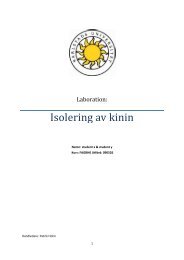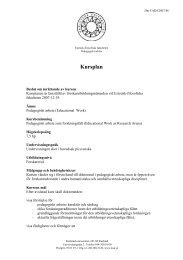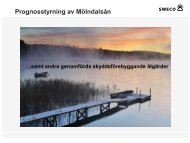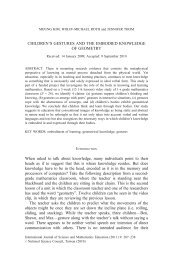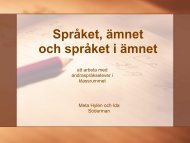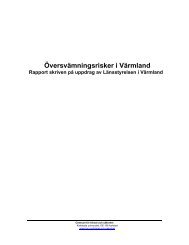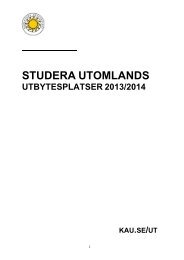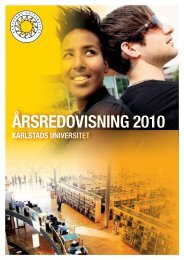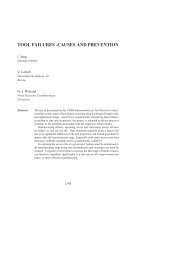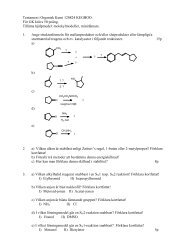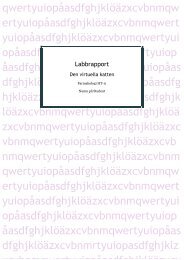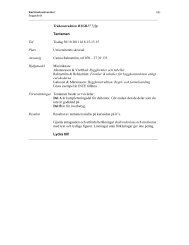WELCOME TO THE FIRST ISSUE OF THE VIPP NEWSLETTER
WELCOME TO THE FIRST ISSUE OF THE VIPP NEWSLETTER
WELCOME TO THE FIRST ISSUE OF THE VIPP NEWSLETTER
Create successful ePaper yourself
Turn your PDF publications into a flip-book with our unique Google optimized e-Paper software.
<strong>VIPP</strong> Values Created inFibre-based processesand productsWelcome to thefirst issue ofthe <strong>VIPP</strong> newsletter<strong>VIPP</strong> stands for Values Created in Fibre-based processes andproducts and is an interdisciplinary, industrial graduate researchcollege located at Karlstad University.Research focus is mainly on the pulp and paper industrial branchand around key technologies of importance for this industry. It isa joint initiative between Karlstad University, the Service ResearchCenter at Karlstad University and the following enterprises: AskoAppliances AB, Billerud AB, BTG Instruments AB, Eka ChemicalsAB, Metso Paper Karlstad AB, Domsjö Fabriker AB, MoRe ResearchAB, Innventia AB, Korsnäs AB, Pöyry Sweden AB, Stora Enso GroupR&D, SSG Standard Solutions Group AB, Stora Enso Skoghall ABand Kemira Kemi AB. Together these partners share a wide varietyof complementary expertise, covering the whole value chain frompulp to final product. The program is financed by the participatingpartners and the Knowledge Foundation.The aim of the <strong>VIPP</strong> research college is to create a researchenvironment where PhD students not only specialize in one areabut gain, through close collaboration and courses, skills in otherresearch areas as well. It is based on three strong research themes,addressing different aspects within industrial R&D and related tofibre-based products and services:• pulp, paper and graphic technologies• environmental and energy research• service-oriented, customer-research activitiesAll of these are well established at Karlstad University and form,together with the expertise from the collaborating enterprises, arobust research platform to start from.The content of this research is focus of this newsletter where ourPhD students present themselves and also their projects.If you want to learn more about us, you are also welcome to browseour new homepage with information about:• General information about <strong>VIPP</strong>• <strong>VIPP</strong>’s organisation• News and Events, including a report about <strong>VIPP</strong>’s kick-offin October 2011• <strong>VIPP</strong> partners and financersWe wish you happy reading!KAU.SE/EN/<strong>VIPP</strong>
<strong>VIPP</strong> Values Created inFibre-based processesand productsA New Sensorfor ImprovedFiberline ControlA new pulp mill sensor that measures the content of dissolved ligninin pulp slurry has been developed by BTG Instruments. This sensoruses a unique method for the analysis of dissolved lignin that resultsin a robust and accurate lignin determination. By using this state-ofthe-artsensor it will be easier to control the washing efficiency of thedifferent washers in the pulp mill, which will lead not only to reducedenergy consumption and lower production cost but also a lowerenvironmental impact.Several individual sensors will be tested in different positions at anumber of kraft and sulphite mills in Sweden and abroad during2011 and 2012. The sensor will at the same time be evaluated atBTG Instruments’ R&D laboratory in Säffle, where a pump loop willbe used to simulate various process conditions.The objectives of the PhD project are: 1) to establish a deepknowledge of how the new information generated by thesensor correlates with conventional pulp mill parameters, 2) todetermine the optimum position for the new sensor, 3) to analysethe improvements that can be obtained in a pulp mill and 4) toinvestigate the underlying process mechanisms.BTG Instruments is a leading supplier of state-of-the-art sensors andanalyzers for the global pulp and paper industry. It is the company’sambition to have a close relationship with Karlstad University andthe <strong>VIPP</strong> Research School to create new knowledge useful both foracademic-scientific purposes and for the support of further productdevelopment activities.Name:Background:Company:Supervisors:Examiner:Caroline WilkeDegree of Master of Sciencein Chemical Engineering (June 2011)BTG Instruments, Säffle, Sweden(start: May 2011)Prof. Ulf Germgård (Karlstad University)and Dr. Niclas Andersson (BTG Instruments)Prof. Ulf Germgård
<strong>VIPP</strong> Values Created inFibre-based processesand productsEfficient dryingof tissue paperThis PhD project is a co-operation between Metso Paper andKarlstad University. Financial support is given by the SwedishKnowledge foundation.The paper production process is in essence a dehydration operation.Stock flow enters the machine at low consistency and water isremoved during forming, by mechanical compression and by thermaldrying. Mechanical dewatering is energy efficient, but the amountof water that can be removed is restricted by press technologylimitations and by desired paper quality which makes the finalthermal drying necessary. Problematically this latter process is veryenergy demanding and is today accountable for approximately 70%of the energy used by a tissue mill.The purpose of this project is to reduce the amount of energy usedfor thermal drying in production of tissue paper. Main areas to beinvestigated are:• Influence of losses on the amount of used energy• Effect of increased yankee hood air humidity andconsequences for runnability• Energy efficiency for possible future drying equipment• Alternative equipment for energy recovery• Adaption of drying system to higher ingoing dryness levelof paper sheetProposed system modifications will be analyzed with regards toimpact on the papermaking process.Name:Anders OttossonProject start: January 2012Supervisors at Prof. Lars Nilsson andKarlstad University: Jonas Berghel, Associate ProfessorSupervisors at Ingvar Klerelid, VP Product Management,Metso Paper: Michael Bjerke, Senior Process Engineer,Hans Ivarsson, Project Manager R&D andOlli Saikkonen, R&D ManagerExaminer:Roger Renström, Associate Professor
<strong>VIPP</strong> Values Created inFibre-based processesand productsInvestigation of the non-uniformityduring dewatering and drying oftissue paper gradesA sheet of paper possesses a local variation in grammage, usuallytermed formation of the sheet. The extent of this variation is mainlydefined by the fibre morphology, the process chemistry and theoperating conditions during the forming of the sheet. For a webwith a low grammage, for example a tissue sheet, the relative extentof this variation is pronounced. Consequently, this variation willhave considerable effect on the efficiency of dewatering and dryingprocesses. For example, during suction-box dewatering, much moreair will flow through areas with lower grammage in comparison toareas with higher grammage. This implies energy inefficiency interms of air consumption. It will most likely also result in a variationin dewatering result, i.e. the locally achieved dryness will vary.The above-described effects have been known to paper andtissue makers for some time; however, very little quantitativeinformation is available. Furthermore, the quantitative influenceof fibre morphology, the process chemistry and the operationconditions has not been studied. Therefore, the main objective ofthe project is to understand and quantify the effect of the sheetnon-uniformity on dewatering and drying efficiency. Furthermore,the quantitative influence of some of the most relevant parameterswill be determined. A particular focus will be put on the influenceof the fiber morphology, for example fiber length and coarseness.Furthermore, energy-related issues of dewatering and drying will beaddressed in order to propose modifications to the existing process.Another effect relates to the drying of these low grammage webs.On the Yankee cylinder or a through air drying (TAD) unit, areas withlower grammage will be dried much faster than areas with highergrammage. This implies that, towards the end of the drying process,the areas with the higher grammage delay the overall dryingprocess. The low grammage areas will be overdried, and, equallyimportant, the process has to be operated at a lower speed than itcould be if the formation of the sheet was more even.Various experimental equipment and methods are available inboth Karlstad (at Karlstad University and at Metso) and Stockholm(Innventia AB). Examples of equipment at Innventia are the highpressure difference laboratory former, the laboratory suction boxincluding rewetting device, the MTS-pressing and drying simulator, thehigh-speed infrared imaging system, and the FEX pilot paper machine.In Karlstad, the following equipment is of interest: dynamic suctionbox (Karlstad University) and pilot tissue paper machine (Metso).Name:Aron TysénDissertation: Planned September 2016Company: Innventia ABSupervisors: Christophe Barbier, PhD, and Hannes Vomhoff, PhDExaminer:Prof. Lars Nilsson
<strong>VIPP</strong> Values Created inFibre-based processesand productsSystems analysisof biorefineriesProfessional profile:20 years experience in technical engineering & consulting, mainly inthe pulp & paper industryCurrent position: Vice President, Biorefining Pöyry Scandinavia.Area of researchBiorefining - Systems analysis of new bio-based products, as well asdirect and indirect biomass supply to new sectors.BackgroundBiomass is foreseen to be an increasingly demanded resource.Over time, new industries such as the chemical, petroleum andpetrochemical industries will gradually base an increasing share oftheir production on renewable raw materials. The biomass may besupplied in unrefined form as round wood or wood chips, or indirectlyfrom the forest industry or the power industry that are the dominantplayers in the market today. For the traditional users of biomass, thisdevelopment thus poses both threats and opportunities.Several factors influence the development: Technology, economicsand authority incentives.Objectives and StrategyThe goal of my research is to systematically identify, analyzeand evaluate products, processes and platforms for industrialbiorefineries, primarily wood-based ones. The research will involvea variety of possible products and processes. Great interest will bepaid to combinations of chemical, biochemical and thermochemicalconversion. The work will not primarily be based on experimentalwork, but rather on industrial experience and the great amount oflaboratory results that are developed at universities and researchinstitutes worldwide.In particular, research focusing on how today’s users of forestresources can add value and how different stakeholders can cooperateto make optimum use of a limited amount of wood, in anenvironmentally-, resource-, business- and socio-economicallyoptimal way.With nearly 20 years experience as a process consultant, I plan tocarry out this analysis with a strong industrial perspective, takinginto consideration actual economic conditions, business models andprofitability requirements.Name:Department:Supervisors:Examiner:Christer GustavssonDepartment of Energy, Environmental andBuilding TechnologyAssociate Prof. Roger Renström, Prof. Lars NilssonAssociate Prof. Jonas Berghel
<strong>VIPP</strong> Values Created inFibre-based processesand productsFood-packagingbarriers fromrenewable resourcesFood packaging is widely used today and, depending on theapplication, different barrier materials are applied to the boardsurface. The function of the barrier is to protect the packaged foodfrom oxygen and other gases, water and moisture, light, and grease.Another important function is to protect the packaging itself fromwater, moisture, and grease.The carbon footprint measures the impact our activities have onthe environment, in particular on climate change. With regard tofood packaging it has become clear that the highest contributionto the carbon footprint comes from the barrier materials, which arebased on plastic and/or aluminium. To reduce the carbon footprinttoday’s barrier materials should be replaced with a renewable barriermaterial with sufficiently good barrier properties to protect thepackaged goods.The aim of this project is to study the oxygen barrier function tomake food-packaging barriers from renewable resources. The barriermaterials studied in this project are composite-based materialsthat have the potential to be used as barrier on board packagingmaterial in the future. First, the barrier materials will be characterisedand their important properties identified. Based on the results,a mathematical model will be developed for the penetration ofoxygen through the barrier.Name:Åsa NyflöttEducation: MSc in engineering physics, KaUCompany: Stora EnsoStarted: September 2011Supervisors: Prof. Magnus Lestelius, Prof. Ellen Moons andDr. Gunilla CarlssonExaminer:Prof. Lars JärnströmMentor:Lic. Tech. Torbjörn Wahlström
<strong>VIPP</strong> Values Created inFibre-based processesand productsFresh fruit and vegetablewaste in the food supply chain– quantification and causesThe result of several international studies suggests that more than30 percent of the food produced for human consumption is lostor wasted globally. In addition to the economic value of the foodproduced, food losses also represent waste of resources usedin production such as land, water, and energy (transportation,fertilizers, man hours, etc.). Of the total food losses, the share offresh fruit and vegetables losses amount to a significant part.The primary purpose of packaging is to protect and preserve thefood, to provide good durability, good quality, and facilitate efficienttransportation as it transits through the food supply chain. If thepackaging cannot handle this adequately, it will cause food lossesand environmental impact with no benefit. The importance ofappropriate packaging design is therefore critical and the impactof using too much packaging material must be put in relation toproduct losses that may result from the use of too little packagingmaterial. Often, the environmental impact of the packaging itselfis relatively small compared to the environmental impact of theproduction of food. Hidden costs associated with handling thewaste are often overlooked. Hidden costs can be caused by poorpackaging, inadequate handling of the produce or the box, and/oran ill-performing cold chain. A more scientific and systematicapproach in this process would significantly reduce these costs andincrease profitability.The aim of this research is to quantify how much fresh fruit andvegetable are lost and wasted in the food supply chain, howmuch the losses cost (calculated both in terms of economicand environmental cost), and identify how these losses can beprevented. Furthermore, the study aims to identify any othereconomic gains that improved packaging solutions would yield,such as lower handling costs, define where waste/inefficiencyproblems occur and who is paying the cost, and identify cost savingopportunities.Vibrations during transportation, transshipment, high humidity,and temperature differences contribute to collapse of the boxesand/or fall. This results in destroyed or damaged products,additional handling, production stops and delays, and lost timein the entire supply chain. A large part of the problem is due toinefficient packaging.Name:Lisa MattssonEducation: MSc Environment and Energy System, 2003,Karlstad UniversityDepartment: Energy, Environmental and Building TechnologySupervisor: Associate Professor Fredrik WikströmExaminer:Prof. Lars JärnströmFinanced by: Billerud, The Knowledge Foundation
<strong>VIPP</strong> Values Created inFibre-based processesand productsEnergy efficientwastewater-treatmentin pulp- and paper millsthrough pretreatmentusing separation.The energy use in wastewater treatment in a pulp and paper settingis affected by the chemical makeup of the wastewater. Differentproduction units at pulp and paper mills produce various chemicalcompounds that negatively affect wastewater treatment. Woodextractives, lignin, bleaching agents and residual sulphite arecommon such chemicals. These compounds increase the costsassociated with wastewater treatment by increasing energy demandand lowering treatment efficiency.In this project, the means and effects of removing wood extractivesand suspended solids from wastewater will be investigated. Severaldifferent separation technologies such as skimming, filtration,selective chemical flocculation and adsorbtion have the capability toperform this function. Specifically, determine how such technologiescan be used to separate said compunds from forest industrywastewaters and to quantify the effect separation would have on theenergy efficiency of aerobic and anaerobic wastewater treatment.Name:Mattias From-AldaronEducation: M.Sc Energy and Environment systems, KaU 2009Company: Stora Enso Skoghall ABSupervisors: Associate Prof. Karin Granström,MSc. Ann-Kristin MagnussonProf. Ulf GermgårdPublications: Sandberg Maria, From-Aldaron MattiasEnergieffektiv aerob rening av skogsindustriellaavloppsvatten 2011.Published in: VÄRMEFORSK rapportdatabas
<strong>VIPP</strong> Values Created inFibre-based processesand productsPredicting flexographic printquality from substrateproperties with special focuson liquid packaging boardsInnventia, Karlstad University and Tetra Pak are collaborating on thisproject. Its aim is to gain a better understanding of print quality andhow the interaction among substrate, ink and flexographic printingpress affects quality. It is very important to be able to predict printquality from an unprinted substrate in production control and whenworking with product improvements.Focus will be on:• Liquid absorption uniformity.How can this be measured in a realistic way with respect toabsorption of water-based flexographic inks? What is its impact onprint mottle?• Ink transfer and print density. Are there limitations in using printdensity as a measure of ink transfer?• Local variations and point-to-point matching. Variations in thethickness of a coating layer are expected to cause variation inporosity, absorption and white-top mottle. Can this be shown?How does it affect print quality?• Dot uniformity and half-tone mottle.Can dot uniformity explain the negative correlation often observedbetween dot gain and half-tone mottle?When interpreting the results it could also be beneficial to study inkpenetration in cross sections of board. The first task will be to studyliquid absorption uniformity and how to measure it.I have been working with aspects of print quality for eight yearsat Innventia and earlier at Stora Enso. I am now looking forwardto my doctoral studies and the possibility of focusing in depth onpredicting the quality of flexographic printing.Name:Company:Supervisors:Examiner:Mentor:Sofia ThormanInnventiaAssoc. Prof. Göran Ström (Innventia)Assoc. Prof. Li Yang (Innventia)Professor Magnus Lestelius (KaU)Professor Magnus Lestelius (Karlstad University)Assoc. Professor Anita Teleman (Innventia)
<strong>VIPP</strong> Values Created inFibre-based processesand productsREDUCTION <strong>OF</strong> <strong>THE</strong> ENERGYUSE IN A TUMBLE DRYER WITHHEAT-PUMP TECHNOLOGYDrying clothes is a large power consumer in a modern home. Themajority of all tumble dryers today are based on old technique. Toreduce the power consumption, heat-pump technology can be used,and there are already some heat-pump tumble dryers availableon the market. The purpose of this paper is to present two futurestudies regarding a heat-pump tumble-dryer process.The first study focuses on the importance of the heat-pumpcompressor capacity in relation to the power consumption of acomplete heat-pump tumble-dryer process with refrigerant 134a.The second study will investigate the possibility to reduce the impacton the environment with other types of refrigerants. The modeland the lab setup from the first study will be used to study R134aand two more refrigerants where at least one should be natural.Important parameters to consider would be SMER of the completeheat-pump tumble-drying process, COP of the heat-pump processand Total Equivalent Warming Impact (TEWI).FanFanA heat-pump tumble-dryer includes two processes: humidityair flow and the heat-pump process. The two processes will bemodelled separately in an Engineering Equation Solver (EES), andalso in combination to study a complete heat-pump tumble-dryingprocess. The model will be validated against a lab setup. Importantparameters to consider will be Specific Moisture Extraction Rate(SMER) of the complete heat-pump tumble-drying process,Coefficient Of Performance (COP) of the heat-pump process.DrumExpansiondeviceHumidity air flowCondenserEvaporatorSub-coolerHeat-pumpprocessCompressorName:Peder BengtssonCompany: Asko AppliancesSupervisor at Asko: Anders SahlenSupervisor at KAU: Jonas Berghel, Associate Professor



